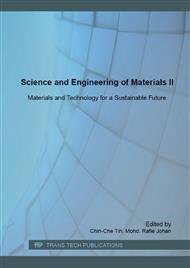[1]
A. Johari, M. C. Bhatnagar, and V. Rana, Growth , characterization and I-V characteristics of tin oxide (SnO2) nanowires, vol. 3, no. 6, p.515–518, (2012).
DOI: 10.5185/amlett.2012.icnano.251
Google Scholar
[2]
S. T. Surachet P. M., Supa C., Nikorn M., Duangmanee W., SnO2 nanowires mixed nanodendrites for high ethanol sensor response, Curr. Appl. Phys., p.6, (2011).
Google Scholar
[3]
C. Gao, X. Li, B. Lu, L. Chen, Y. Wang, F. Teng, J. Wang, Z. Zhang, X. Pan, and E. Xie, A facile method to prepare SnO2 nanotubes for use in efficient SnO2-TiO2 core-shell dye-sensitized solar cells, Nanoscale, vol. 4, no. 11, p.3475–3481, Jun. (2012).
DOI: 10.1039/c2nr30349c
Google Scholar
[4]
Q. T. Khuc, X. H. Vu, and D. V. Dang, The influence of hydrothermal temperature on SnO2 nanorod formation, vol. 025010, p.1–5.
Google Scholar
[5]
A. Kar and A. Patra, Recent development of core–shell SnO2 nanostructures and their potential applications, J. Mater. Chem. C, vol. 2, no. 33, p.6706, May (2014).
DOI: 10.1039/c4tc01030b
Google Scholar
[6]
I. Puertas Arbizu and C. J. Luis Pérez, Surface roughness prediction by factorial design of experiments in turning processes, J. Mater. Process. Technol., vol. 143–144, p.390–396.
DOI: 10.1016/s0924-0136(03)00407-2
Google Scholar
[7]
A. A. Francis and A. A. El-Midany, An assessment of the carbothermic reduction of ilmenite ore by statistical design, J. Mater. Process. Technol., vol. 199, no. 1–3, pp.279-286.
DOI: 10.1016/j.jmatprotec.2007.08.031
Google Scholar
[8]
Zhong. W. Nanoscience and Nanomaterials: Synthesis, Manufacturing and Industry Impacts. Lancaster, PA: Destech Publications, (2012).
Google Scholar
[9]
C. Rodwihok, A. Gardchareon, and S. Phadungdhitidhada, Synthesis and Characterization of Vertically Aligned ZnO Nanowires by Chemical Vapor Deposition, vol. 25001, p.1–3, (2014).
Google Scholar
[10]
M. S. Al-Ruqeishi, R. M. Nor, Y. M. Amin, and K. Al-Azri, Direct growth and photoluminescence of silicon nanowires without catalyst, Arab. J. Chem., (2013).
DOI: 10.1016/j.arabjc.2013.07.032
Google Scholar
[11]
C. Taejin, K. Hyungjun, K. Doyoung, C. Taehoon, and K. Soohyun, Synthesis of Si Nanowires by Using Atmospheric Pressure Chemical Vapor Deposition with SiCl4, J. Korean Phys. Soc., 59, no. 21, p.485, Aug. (2011).
DOI: 10.3938/jkps.59.485
Google Scholar


